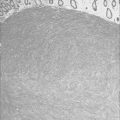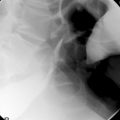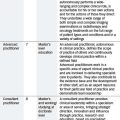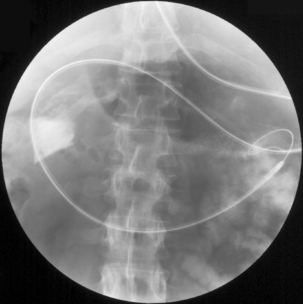CHAPTER 19 Introduction to the reporting of gastrointestinal (GI) radiological procedures
Introduction
The reporting of radiological (medical imaging) procedures has traditionally been performed by radiologists (specialist medical doctors). However, initially in medical ultrasound (US), due to increasing workload and a shortage of radiologists beginning in the 1970s, there has been a gradual shift within the UK to reporting duties being undertaken by allied healthcare practitioners, predominantly radiographers (Fernando, 1999).
The precedent from US imaging was expanded into Accident and Emergency (A&E) radiographic imaging, initially with an abnormality flagging system, often called the ‘red dot’ system (Berman et al., 1985; Nuttall, 1995). This subsequently developed into reporting of a wider range of plain radiographs by radiographers (Quick, 1993; Robinson, 1996a; Robinson et al., 1999a) and from there expanded into most other subspecialties of medical imaging (Culpan, 2006).
Although there is no specific requirement that the delegation of medical image reporting be to a specific professional group (General Medical Council, 2001), the delegation process should be robust and take into account the skills base of those to whom the task is delegated.
In the field of GI imaging, the first area of delegated practice to be undertaken (and subsequently reported) by radiographers was the double contrast barium enema (DCBE) (Mannion et al., 1995). Radiographer reporting of DCBE was shown to be of similar accuracy to radiologist reporting (Law et al., 1999; Culpan et al., 2002, 2003; Booth and Mannion, 2005).
Reporting standards
Standards of reporting are important, not least because cases may be tested in a Court of Law. As such, the standards achieved by the healthcare professional undertaking the delegated reporting role must at least match the standards of the professional group which had previously performed the role, namely the clinical radiologists (Dimond, 2002, 366-7). The RCR produced standards for reporting for radiologists (The Royal College of Radiologists, 2006) which consequently must also apply to all others undertaking the reporting role.
Practical skills
Observation and interpretation
Digital format has several advantages (e.g. the potential for manipulation of the image after it has been captured); however, the uninitiated may simulate or mask/obscure pathology by incorrect manipulation of images. Transfer of images in digital format is also simplified; no longer does the reporting professional have to wait for ‘hard copy’ images or carry around stacks of photographic film. Electronic digital image files can now be transferred to image reporting stations within (and outside) the healthcare facility in which they are acquired.
Although pattern recognition has its uses, there are potential downfalls to relying on the process. For instance, if a pattern demonstrated is not one that the viewer has seen before, or is not one they are completely familiar with, it may not be recognized. In such cases, even quite obvious abnormalities may be ignored as the individual is only looking for ‘what they know’. To overcome this limitation, the trainee reporting practitioner is taught to review medical images systematically, interrogating the whole image sequentially, looking at all parts of an image and all images within each particular examination or study. This may be quite challenging since with multidetector CT examinations (MDCT) and multisequence MR studies, there may be 300–500 individual images in a single study (Fishman, no date). When, therefore, it is not possible to scrutinize each image in detail, pattern recognition remains the primary method of review. This process may be facilitated by computer-assisted detection (CAD) software, application specific programs being commonplace for virtual colonoscopy (VC) for instance, to highlight potential pathology.
It is also important that personnel involved in image interpretation and reporting understand the clinical information provided by the referring clinician (The Royal College of Radiologists, 2006). In the UK, there is a legal requirement that this is sufficient to enable the radiologist or radiographer to ‘justify’ the examination with respect to the ionizing radiations (medical imaging) regulations (IR(ME)R 2000) (Department of Health, 2000). Clinical information in the referral should convey any relevant signs and symptoms elicited from the patient’s medical history, physical examination and laboratory tests and should give a provisional diagnosis or suggest differentials. The referral is often expressed in terms of a ‘clinical question’, for instance, a patient with unexplained iron deficiency anemia may be referred for a range of diagnostic tests such as initial esophago-gastroduodenoscopy (OGD) and subsequent DCBE or colonoscopy to confirm or refute the presence of a colonic source of bleeding such as a cecal tumor.
Reporting style and structure
Most medical imaging reporters use a free text type report, although alternatives include a pre-defined proforma style, where specific questions are answered or pre-coded standard phrases selected (Naik et al., 2001). Each style has its own strengths but the recommended structure expected of medical imaging reports is defined by the The Royal College of Radiologists (2006). Initially, a report should contain patient identifying information to ensure that a specific report can be related to a specific patient on a specific occasion, as misidentification can have significant, potentially serious adverse consequences.
Next should follow a description of the imaging findings (The Royal College of Radiologists, 2006) in terms of size, shape, outline contour, position and radiographic characteristics. The overall radiological findings must then be related to the presence or absence of pathology. Comments can be made on normal findings where this refutes the clinical question or where there is a variance of normal anatomy, e.g. malrotation of the colon or situs inversus.
Communication
Communication of the report to the referrer is of paramount importance as the report is the end result of the imaging examination (The Royal College of Radiologists, 2007). It is important that the referrer can understand the report and that it is written in plain language, devoid of jargon and obscure terminology.
The distinction between a ‘descriptive report’ offered by an allied healthcare professional and a ‘medical report’ offered by a clinical radiologist is one that should be made on the grounds of authorship (Robinson, 1996b). Only a medical practitioner can provide a ‘medical report’, anything else is considered a ‘descriptive report’ regardless of content, thus the authorship and professional status of the reporter should be stated in the report somewhere (Dimond, 2002).
Where there are urgent or unexpected abnormal findings, e.g. obstructing tumor, these should be communicated rapidly to the referring clinician and this procedure documented (The Royal College of Radiologists, 2006). To ensure that the referrer is aware of the situation, direct communication, such as face-to-face or telephone conversation is always best, as a written note, memo, letter, fax, e-mail or voice mail may be ignored, lost, erased in error, or its urgency or significance may not be appreciated if it is received by an inappropriate member of the healthcare team.
In recognition of this issue, the National Patient Safety Agency (NPSA, 2007) reported a number of incidents which had led to patient fatalities and significant long-term harm when there had been failures to follow up on medical imaging reports.
It is unusual for patients to be told the results of a medical imaging investigation at the time of the investigation. This is because the referrer will be the person with all the relevant information pertaining to the range of clinical, laboratory and imaging investigations and how the results of these all fit together to inform the care or treatment plan for the individual patient. It is often frustrating for patients to be told that they must see the referring clinician again for the results, but allied healthcare professionals (AHPs) must be trained to deal with such delicate situations. There are some situations where AHPs do give results (e.g. in obstetric ultrasound) but this is only after specific training has been undertaken and is within the remit of an agreed protocol which outlines their responsibility and scope of practice (Simpson, 2001).
Terminology
The terminology used in imaging reports (and of course in the clinical history provided by the referrer) is important; all parties involved need to understand the terms and phrases used. It is very easy to use abbreviations, acronyms and technical or professional jargon, which are perfectly reasonable in context, but are open to misinterpretation. Some examples of terms with multiple meanings are shown in the Table 19.1.
Table 19.1 Standard abbreviations and their multiple clinical meanings
| Abbreviation | Possible meanings |
|---|---|
| Ca | Calcium |
| Carcinoma | |
| Cardiac arrest | |
| Contrast agent | |
| Chronological age | |
| Citric acid | |
| MS | Multiple sclerosis |
| Mitral stenosis | |
| Musculoskeletal | |
| Medical student | |
| Medical surgical | |
| Metabolic syndrome | |
| Munchausen’s syndrome | |
| Morphine sulfate | |
| IHD | Ischemic heart disease |
| Intermittent hemodialysis | |
| Intrahepatic duct(s) | |
| Implantable hearing device | |
| DM | Diabetes mellitus |
| Doctor of medicine | |
| Dopamine | |
| Dextromethorphan | |
| Dermatomyositis | |
| Dystrophia myotonica | |
| Diastolic murmur | |
| NAD | No abnormality detected |
| No active disease | |
| No acute distress | |
| No apparent distress | |
| Nicotinamide adenine dinucleotide | |
| Nitric acid dihydrate | |
| PMH | Past medical history |
| Psychiatric/mental health | |
| Profoundly mentally handicapped | |
| Postmenopausal hormone | |
| CF | Cystic fibrosis |
| Cardiac failure | |
| Cerebrospinal fluid | |
| Cervical fracture | |
| Contributing factor | |
| Childfree | |
| Caucasian female | |
| Confer (Latin: Compare) | |
| PID | Prolapsed intervertebral disk |
| Protruded intervertebral disk | |
| Pelvic inflammatory disease | |
| Pain intensity difference | |
| Phosphotyrosine interaction domain | |
| Photoionization detector | |
| Picture image directory | |
| Plasma iron disappearance | |
| Plus integral plus derivative | |
| Poisons information database | |
| Postinertia dyskinesia | |
| Postinfection day | |
| Postinoculation day | |
| Preimplantation diagnosis | |
| Primary immunodeficiencies | |
| Primary immunodeficiency diseases | |
| Principal immunodominant domain | |
| Proliferative intraocular disorders | |
| Proportional-integral-derivative | |
| OGD | Esophago-gastroduodenoscopy |
| Osteoglophonic dysplasia | |
| Osteoglophonic dwarfism | |
| Old granulomatous disease |
Adapted from GlobalRPh.com 2007.
In the same way, use of ambiguous reporting terminology is to be discouraged when describing medical imaging findings. Although conventions are important, key stakeholders need to know what the conventions are. For instance, diverticulosis, seen on a DCBE, may be described as mild, moderate or severe, but it is important to ensure that there is consistency between individual reporting personnel so that the referrer knows just what degree of disease is implied when each term is used. If one observer states that disease is moderate while another calls it severe and a third observer calls it moderately severe, the clinician will find it unhelpful. To avoid this, a local agreement/consensus should be reached, for example, mild diverticulosis might be defined as ‘some scattered diverticula’, moderate disease as more concentrated in a particular segment and includes circular muscle thickening, and the term severe reserved for cases where the disease interferes with confidence of diagnosis or exclusion within a particular segment. Such agreement must involve all interested parties, i.e. referrers and reporters.
As in any specialty, specialized language is often used in relation to specific imaging techniques such as ‘signal intensity’, ‘enhancement pattern’ or ‘echogenicity’ but, wherever possible, ‘jargon’ terms should be kept to a minimum unless the reporter is sure that the intended recipient (referrer) will understand the terms used. Where there is evidence of a pathological process, this should be commented upon and interpreted as either significant findings (related to the current signs and symptoms) and thus requiring some intervention, or be categorized/classified as insignificant findings where incidental findings such as degenerative disease, inactive colitis or diverticulosis are not considered to be responsible for the patient’s current presentation. Significant findings must be analyzed to suggest a diagnosis or list of differentials. Occasionally, specific findings cannot be attributed to a single pathological process. For example, extrinsic compression of the colon noted at DCBE can have a range of causes which produce the same imaging appearances (Blakeborough et al., 2001). In such cases, the differential list should start with the most likely possibility. Wherever possible, the report should contain a recommendation as to any further investigations that might be suitable for clarifying such a diagnostic dilemma; in the aforementioned example, this might include abdominal and pelvic CT to characterize the nature of an extrinsic mass.
Clinical coding systems, such as READ or SNOMED CT are used in administration systems to ensure compatibility and standardization across institutions/electronic recording systems (NHS, 2007), but are not used in the generation of medical imaging reports at the time of writing. Hypothetically, this might be a future development with computerized reporting systems in medical imaging departments linking electronic/voice recognition reporting with the applications codes to keep the report as an integral part of the image file.
When static images are available for a particular examination, a ‘double reporting’ process is recommended in some areas of medical imaging. Such practice is routine in mammographic breast screening, as it is more cost effective in terms of reducing the number of ‘false positive’ recalls for further assessment than single reading and it increases the cancer detection rate (Brown et al., 1996). Double reporting has been recommended for use in DCBE as it increases the sensitivity but inevitably decreases specificity of the examination (Markus et al., 1990; Anderson et al., 1991). However, where the examination images are dynamic, such as in ultrasound or videofluoroscopy, double reporting is problematic unless the entire study is stored and available for review on a separate workstation. This was not realistically feasible before the advent of PACS (picture archiving and communication system) due to the large data storage requirements and the time constraints of second real-time review of a dynamic study, i.e. at least the same length of time as taken to perform the original study. However, the benefits of being able to review dynamic studies digitally and frame by frame or in slow motion should not be underestimated.
Audit of reporting practice
In keeping with the clinical focus of reporting training at UK universities, these courses have some form of clinical assessment of report writing skills. For many this involves an audit of the student’s reports and these are compared to the reports which were issued – to check for concurrence. Typically, 95% concurrence (Table 19.2) is required in plain film reporting and this may be carried over to more complex examinations, although it must be recognized that variation between observers is likely to be higher (Robinson, 1997) as no-one is perfect and disagreements are likely on the more difficult cases. One hundred percent accuracy is not the norm expected of radiologists reporting medical imaging studies and there has historically been research to assess the level of errors and variation for various types of medical imaging examinations (Robinson, 1997); a 5% error rate is deemed acceptable of competent individuals (Dimond, 2002).
Table 19.2 Definitions of key terms associated with measurement of reporting accuracy
| Radiological term | Definition |
|---|---|
| Reference (gold) standard | Standard against which accuracy is measured. May be another observer (e.g. experienced radiologist) or against another test |
| True positive (TP) | A correct decision which identifies abnormality when it is present |
| True negative (TN) | A correct decision which identifies normality when no pathology is present |
| False positive (FP) | An incorrect decision which identifies abnormality when none is present |
| False negative (FN) | An incorrect decision which identifies normality when a pathology is present Also known as a perception error |
| Sensitivity | The ability to identify pathology within a population. The true positive percentage |
| TP/(TP+FN) × 100 | |
| Specificity | The ability to identify normality within a population. The true negative percentage |
| TN/(TN+FP) × 100 | |
| Accuracy | How often we make the correct decision. A combination of sensitivity and specificity values |
| TP + TN/total number of cases × 100 | |
| Concurrence | Complete inter-observer agreement |
| Partial concurrence | General inter-observer agreement, but: minor pathology missed extent of disease incorrectly identified |
| Non-concurrence | Disagreement between observers – a false positive or false negative in which patient management would have been affected |
| Reproducibility | How often we get the same result (not necessarily the correct result!) |
| Error | Those interpretations which differ from the consensus view of a panel of ‘experts’ |
| Types of error = technical; perceptual; interpretational; communication | |
| Observer variation | Where experts fail to achieve consensus |
| Discrepancy | Reporting errors which come to light at a later date with the benefit of additional information |
| Critical incident | A critical incident occurs when an error results in mismanagement of the patient with resultant morbidity or mortality, requiring mandatory further investigation |
Since the Accident and Emergency department was one of the first places where reporting was delegated by radiologists to other healthcare professionals, most often radiographers, this is one area where discussion of potential error rates has been widest (Robinson et al., 1999b). These discussions involve comparing radiologists with casualty doctors, radiologists with radiographers, casualty doctors with nurses and there has been a wide range of published papers covering these issues, each showing that, while different healthcare professionals can be compared to each other, there is no agreed standard across the professional boundaries. Clinical radiologists are deemed competent by passing the FRCR examinations, radiographers will have to prove themselves during a post graduate M-level course at one of the universities, casualty doctors have little or no specific reporting training and nurses generally match themselves to this latter group.
If the reporting practitioner has proven during the training phase to be able to produce reports with a less than 5% error rate, then during the practice of reporting this standard must be maintained and this is checked by regular audits of performance and accuracy. This varies between hospitals and departments from monthly random samples of reports to annual audits where the reporter is required to repeat an audit of reports. Departments undertaking DCBE will undertake an annual audit of colorectal cancer detection as laid down by the RCR and inherent in this is a check of report quality since it is the accuracy of reporting of cancer by which the test is judged (Tawn et al., 2005).
Conclusion
Traditionally, the reporting of medical images has been undertaken by clinical radiologists but, over a period of time, it has become accepted that non-radiologists can undertake this task, either other doctors or allied healthcare professionals.
Reporting of GI examinations may be undertaken by clinical radiologists, but increasingly this task is being delegated to allied healthcare professionals who are trained to undertake and report either specific examinations or a range of examinations of a particular body system or organ (The Royal College of Radiologists, 2006).
The Gastrointestinal Radiographers Special Interest Group (GIRSIG) was set up in 1998 to support such practice, whether it was established or in development and there is a wide support network of local groups feeding into a national group which has an active website (www.girsig.co.uk), biannual magazine and biennial conference to continue this support.
Anderson N., Cook H.B., Coates R. Colonoscopically detected colorectal cancer missed on barium enema. Gastrointest. Radiol.. 1991;16(2):123-127.
Berman L., de Lacey G., Twomey E., Twomey B., Welch T., Eban R. Reducing errors in the accident department: a simple method using radiographers. Br. Med. J.. 1985;290(6466):421-422.
Blakeborough A., Chapman A.H., Swift S., Culpan G., Wilson D., Sheridan M.B. Strictures of the sigmoid colon: barium enema evaluation. Radiology. 2001;220:343-348.
Booth A.M., Mannion R.A.J. Radiographer and radiologist perception error in reporting double contrast barium enemas: a pilot study. Radiography. 2005;11:249-254.
Brown J., Bryan S., Warren R. Mammography screening: an incremental cost effectiveness analysis of double versus single reading of mammograms. Br. Med. J.. 1996;312(7034):809-812.
Culpan D.G. Development of radiographer reporting into the 21st century. Imag. Oncol.. 2006:38-45.
Culpan D.G., Mitchell A.J., Hughes S., Nutman M., Chapman A.H. Double contrast barium enema sensitivity: a comparison of studies by radiographers and radiologists. Clin. Radiol.. 2002;57:604-607.
Culpan G., Mitchell A., Rock C., Ackerley C.. Radiographer reporting accuracy of double contrast barium enema (DCBE) examinations. 2003. UKRC 2003
Department of Health. The Ionising Radiation (Medical Exposure) Regulations 2000. 2000. Department of Health, http://www.opsi.gov.uk/si/si2000/20001059.htm accessed 08 May 2008
Dimond B.C. Legal aspects of radiography and radiology. Oxford: Blackwell Science Ltd, 2002.
Fernando R. The radiographer reporting debate – the relationship between radiographer reporting, diagnostic ultrasound and other areas of role extension. Radiography. 1999;5:177-179.
Fishman E.K.. General, multidetector CT scanning (MDCT): a primer of practical decision making. Ctisus.. 2008 http://www.ctisus.org/multidetector/syllabus/multidetector_article1.html accessed 08 May 2008.
General Medical Council. Good medical practice. General Medical Council, 2001.
GlobalRPh.com.. Common medical abbreviations. 2007 http://www.globalrph.com/abbrev.htm accessed 08 May 2007.
Law R.L., Longstaff A.J., Slack N. A retrospective 5-year study performed on the accuracy of barium enema examination performed by radiographers. Clin. Radiol.. 1999;54:80-84.
Mannion R.A.J., Bewell J., Langan C., Robertson M., Chapman A.H. Barium enema training programme for radiographers: a pilot study. Clin. Radiol.. 1995;50:715-719.
Markus J.B., Somers S., O’Malley B.P., Stevenson G.W. Double-contrast barium enema studies: effect of multiple reading on perception error. Radiology. 1990;175:155-156.
Naik S.S., Hanbidge A., Wilson S.R. Radiology reports: examining radiologist and clinician preferences regarding style and content. Am. J. Roentgenol. 2001;176:591-598.
National Patient Safety Association. Safer practice notice. Early identification of failure to act on radiological imaging reports. 2007. February 2007 http://www.npsa.nhs.uk/nrls/alerts-and-directives/notices/radiological/ Accessed 20/10/08
NHS. Connecting for health. SNOMED CT – the language of the NHS care records service: a guide for NHS staff in England. London: HMSO, 2007.
Nuttall L. Changing practice in radiography. In: Patterson A., Price R., editors. Current topics in radiography 1. London: WB Saunders, 1995.
Quick J. Radiographers to interpret films. Radiogr. Today. 1993;59:1.
Robinson P.J. Short communication: plain film reporting by radiographers – a feasibility study. Br. J. Radiol.. 1996;69(828):1171-1174.
Robinson P.J.A. The nature of image reporting. In: Patterson A., Price R., editors. Current topics in radiography 2. London: WB Saunders, 1996.
Robinson P.J.A. Radiology’s Achilles heel: error and variation in the interpretation of the Roentgen image. Br. J. Radiol.. 1997;70:1085-1098.
Robinson P.J.A., Culpan G., Wiggins M. Interpretation of selected accident and emergency radiographic examination by radiographers: a review of 11000 cases. Br. J. Radiol.. 1999;72:546-551.
Robinson P.J.A., Wilson D., Coral A., Murphy A., Verow P. Variation between experienced observers in the interpretation of accident and emergency radiographs. Br. J. Radiol.. 1999;72:323-330.
Simpson R. I’m not picking up a heart-beat’: experiences of sonographers giving bad news to women during ultrasound scans. Br. J. Med. Psychol.. 2001;74:255-272.
Tawn D.J., Squire C.J., Mohammed M.A., Adam E.J. National audit of the sensitivity of double-contrast barium enema for colorectal carcinoma, using control charts. Clin. Radiol.. 2005;60:558-564.
The Royal College of Radiologists. To err is human. The case for review of reporting discrepancies. London: Royal College of Radiologists, 2001.
The Royal College of Radiologists Board of the Faculty of Clinical Radiology. Standards for the reporting and interpretation of imaging investigations. London: Royal College of Radiologists, 2006.
The Royal College of Radiologists Board of the Faculty of Clinical Radiology. Making the best use of clinical radiology services, sixth ed. London: Royal College of Radiologists, 2007.









